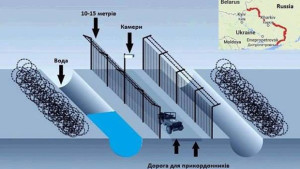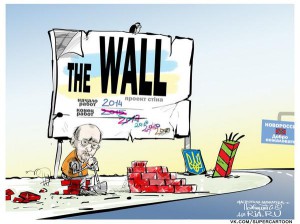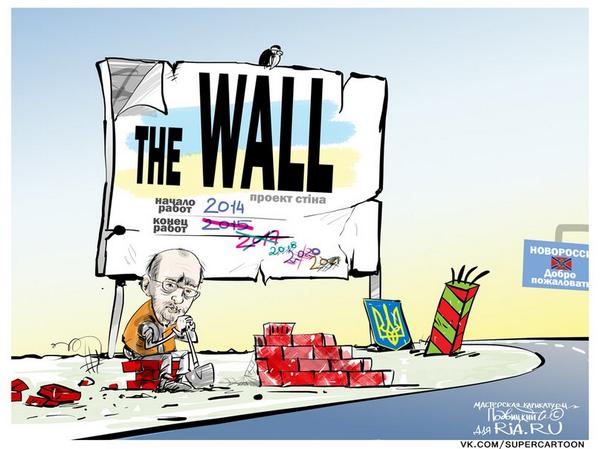Amid tensions between Ukraine, the eastern separatist regions and Russia, Ukrainian politician Igor Kolomoyski, proposed the building of a wall along the eastern border of Ukraine in June 2014. He claimed this wall, projected to be 1,920 km long could be built for $133 million, was claimed to be able to be completed in six months. This plan proposed that the wall would be “blocked by deep and wide ditches and barbed wire” and the space between the ditches and the electrified fence would have anti-personnel mines, along with Ukrainian army, national guard and border guard personnel patrolling.

After several months of deliberation, Ukrainian Prime Minister Arseniy Yatsenyuk announced on September 3, 2014, that the government of Ukraine was beginning to work on a wall that would serve to be a physical state border with the Russian Federation. This plan called for a four-metre wide and two-metre deep ditch and be equipped with electronic monitoring systems. The sea border is also planned to be under full electronic surveillance.
This announcement sparked the government of the self-proclaimed Donetsk People’s Republic (DPR) to state on September 4, 2014, that they will not allow this wall to be built on its territory. DPR Vice Premier Andrei Purgin wondered how Ukrainian troops hoped to enter militia-held territory. As a reminder, the Minsk Protocols were signed on September 5, 2014, which led to the ceasefire.
The order to build the wall was issued by President Petro Poroshenko on September 10, 2014. Under these orders, the plan would cover 1,500 km of ditches and passageways, with thousands of kilometres of trenches for vehicles and 4,000 dugouts. In addition, there would be 60 km of ‘blast resistant’ fencing. The plan for initial development of the wall, was to begin in the Chernigov, Sumy and Kharkiv regions, north of the border of Luhansk, possibly because these areas are free from conflict and under Ukrainian control. The budget was set at 66 million euros.
On September 11, 2014, Russian border officials reported that activity had begun in the Bryansk border region. This area had already seen ditch digging at the border, starting in 2005, but at the time, these were put in place to help prevent smuggling in the region. This particular section of the border is 354 km.
The first stage of the border wall was slated to be completed by September 30, 2014, and this section was allocated $7.7 million to modernize the Ukrainian border. To help facilitate the integrity of their borders, Ukraine had temporarily suspended operations at 16 of the 65 border checkpoints as part of urgent policy to enhance the nation’s defensive capacity.
However, on October 1, 2014, Kiev revised the project plan, putting the Ukrainian Border Guard Service in charge to help ease procedures and bring the necessary border facilities into operation. The first phase of the project did not meet projected deadlines of being ready on September 30, 2014, and instead a new deadline will need to be determined.
It would not be until October 8, 2014, that Kiev would allocate additional funds, bringing the total amount already invested to $18 million. Yatsenyuk said that the priority was to secure the border, and that without that the implementation of the peace plan would be impossible.
It should be noted that the border between Russia and Ukraine is full delimited. The wall is putting a physical border in place where one did not really exist. The only pre-existing border dispute between the two countries is in the Kerch Strait, which links the Sea of Azov to the Black Sea. This dispute has existed since the Soviet Union collapsed. As such, the wall project is one of demarcation, rather than delimitation.
This project has naturally met with much Russian criticism, with both the Russian government and Greenpeace citing the impact that this wall could have on the ecological path of local flora and fauna, particularly given its proximity to the Bryansk Forest, a major biosphere reserve located 30 km from the border. Speaker of the Russian Federation Council Valentina Matviyenko said that this wall is a half-baked and unprofessional step. Rather than global work towards freedom of travel, she believes that building a wall “sounds like savagery.”
Even Ukrainian politician Yulia Tymoshenko has been quoted as saying the project is ineffective and may be used as a budget write-off. She, like many others, have joined together in saying that the experiences of other such walls; the Great Wall of China, the Maginot Line or the Mannerheim Line, have been ineffective at stopping aggression, either being bypassed or destroyed.

However, Yatsenyuk is saying that a visa-free regime with Europe or possible Ukrainian membership in NATO is impossible without this wall. He continues to say that this wall will act to stop illegal migrants and smuggling, as well as being the first line of defence. Yatsenyuk remains convinced that a complete fortification of the Ukrainian border with Russia would speed up Ukraine’s integration into NATO. This idea seems a little far-fetched, particularly given the project has already become marred with inefficiencies. For example, on October 15, 2014, only an 80-meter long and three meter wide anti-tank ditch had been completed. With the proposed budget for the project being set at 66 million euros (approximately $80 million USD), and about $18 million having been spent so far, the remaining stretch of wall needed to be built looks to be a long way from being completed and the budget seems rather low, given what has already been spent and the returns from this investment.
Opposition politicians in Ukraine do not support the project. As previously mentioned, Yulia Tymoshenko has projected that this endeavour will be held back by inefficiency. Former Deputy Prime Minister Valery Khoroshkovsky went as far as to say that this wall was an unaffordable luxury.
Walls are an ineffective way to defend your border. The Great Wall of China was ineffective. The Germans simply walked around the Maginot Line. The Mannerheim Line was no match for sheer Soviet numbers, which the Ukrainians should be all too familiar with.
While the integrity of nation’s borders is an essential element to ensuring national security, the importance of friendly relations between Ukraine and Russia is essential to Ukraine. The two nations are intrinsically tied and while there is clearly friction in their relations, only time and trade can bring the two back together. Walls will get in the way.




